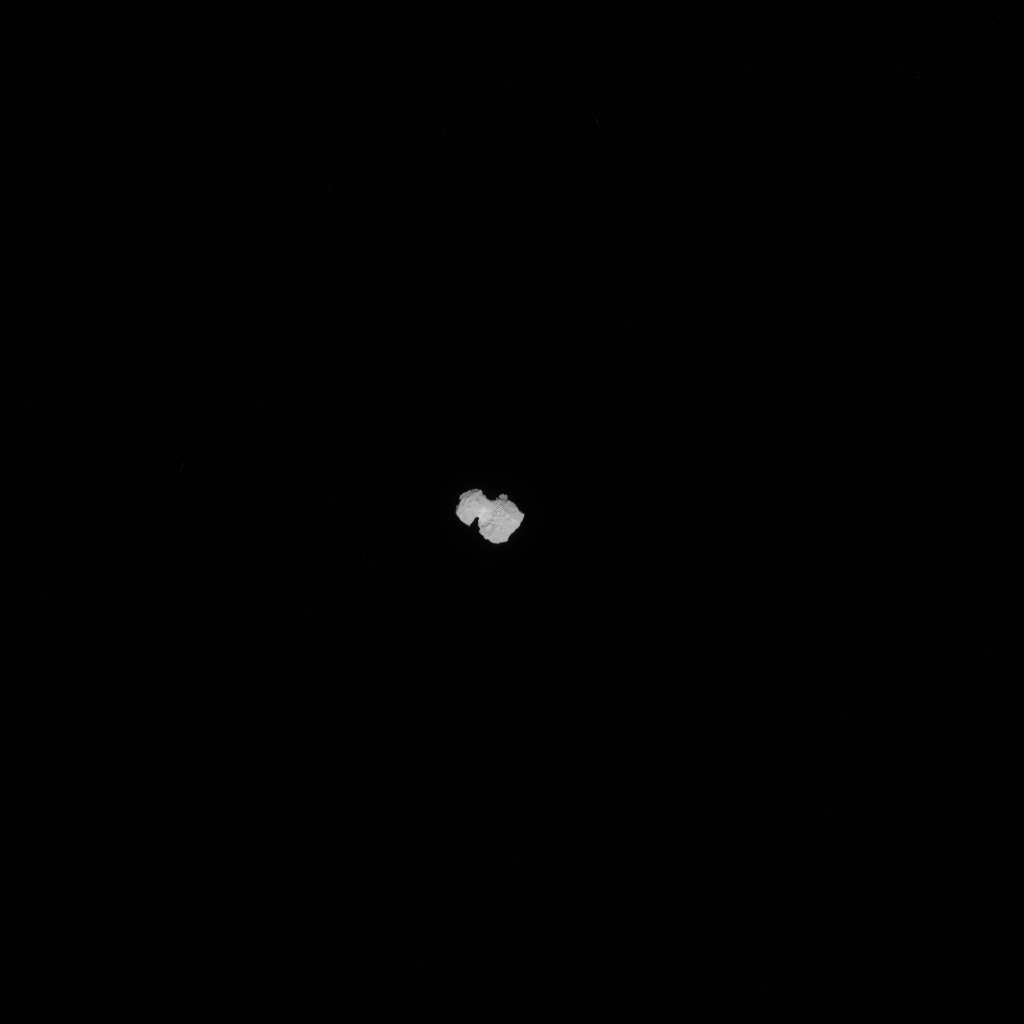The Comet as Landscape Art
 [Image: Photo courtesy ESA].
[Image: Photo courtesy ESA].Intrigued by these images as an example of how the tradition of landscape representation has rapidly progressed—from the Romantics and the Hudson River School to Rosetta—I felt compelled to post a few photos of the craggy and glacial surface of Comet 67P/Churyumov–Gerasimenko, sent back to Earth yesterday from the European Space Agency's Rosetta spacecraft.
The surface of the comet "is porous, with steep cliffs and house-sized boulders," making it earth-like yet deeply treacherous, an irregular terrain to photograph and a dangerous place to land.
 [Image: Photo courtesy ESA].
[Image: Photo courtesy ESA].It is the notion of "land" here that is most interesting, however, as this is really just the imposition of a terrestrial metaphor onto a deeply alien body. Yet the comet is, in effect, literally a glacier: a malleable yet permanently frozen body of ice hurtling through space, occasionally exploding in comas and tails of vapor.
It is "an ancient landscape," we read, "and yet one that looks strangely contemporary as the sun vaporizes ice, reworking the terrain like a child molding clay."
Think Antarctica in a winter storm, not southern Utah—or Glacier National Park, not the Grand Canyon.
 [Image: Photo courtesy ESA].
[Image: Photo courtesy ESA].Along those lines, some of the most provocative writing on what it means to visually represent the frozen and hostile landscapes of the Antarctic is by writer William L. Fox, whose work offers some useful resonance here.
Fox has written, for example, about the technical and even neurological difficulties in accurately representing—let alone comprehending or simply navigating—Antarctic space and the vast forms that frame it.
Distant landscapes distorted by thermal discontinuities; white levels pushed to the absolute limit of film chemistry; impossible contours throwing off any attempt at depth perception; even the difficulty of distinguishing complicated mirages from actual landforms: these are all part of the challenge of creating images of an exotic landscape such as the Antarctic.
As Fox writes, it was even specifically the tradition of Dutch landscape painting, combined with the maritime practice of sketching coastal profiles, that first introduced the visual world of the Antarctic to western viewers: it was thus seen as an ominous, ice-clogged horizon of fog and low clouds looming always just slightly out of ship's reach at the bottom of the world.
He calls this the genre of "representational exploration art."
 [Image: Photo by Stuart Klipper from his fantastic book, The Antarctic: From the Circle to the Pole, with a foreword by William L. Fox].
[Image: Photo by Stuart Klipper from his fantastic book, The Antarctic: From the Circle to the Pole, with a foreword by William L. Fox].In one interesting passage in his book Terra Antarctica, he suggests that the south polar landscape is so extreme, it often resists natural analogy. As Fox describes it, the wind-carved boulders and isolated pillars and cliffs of ice are more like "artworks by Salvador Dalí and Henry Moore, evoking the spirit of surrealism with the former and modernist forms with the latter. The Antarctic is so extreme to our visual expectations that, once we attempt to move beyond measurement to describe it, analogies with other parts of nature fall short, and we resort to comparisons with cultural artifacts that push at the boundaries of our perceptions."
These include "cultural artifacts such as sculpture and architecture, products more of the imagination than of nature."
Consider, for instance, that comet 67P is widely known today as the "rubber-duck comet" due to its bifurcated structure, implying, as Fox suggests with the Antarctic, that no natural analogy seemed adequate for describing the comet's geometry.
 [Image: The gateway arches of the Antarctic; photo by Stuart Klipper from, The Antarctic: From the Circle to the Pole, foreword by William L. Fox].
[Image: The gateway arches of the Antarctic; photo by Stuart Klipper from, The Antarctic: From the Circle to the Pole, foreword by William L. Fox].But what are we to make of comet 67P now that we can see it as a physical landscape, not just an ephemeral optical phenomenon passing, at great distance, through the sky? When a blur becomes focused as terrain, what is the best way to describe it? What visual or textual traditions are the most useful or evocative—vedas and sutras or laboratory reports?
Put another way, is poetry as appropriate as a scientific survey in such a circumstance—should "we attempt to move beyond measurement to describe it," in Fox's words—and, if not, what new genres of exploration art might result from this spatial encounter?
I'm reminded here of poet Christian Bök's wry remark on Twitter: "I am still amazed that poets insist on writing about their divorces, when robots are taking pictures of orange, ethane lakes on Titan..."
Now that humans are beginning to land semi-autonomous camera-ships on the frozen ice fields of passing comets, sending back the (off)world's strangest landscape art—as if a direct line runs from, say, the pastoral landscapes of Claude Lorrain or the elemental weirdness of J.M.W. Turner to the literally extraterrestrial boulders and gullies depicted by Rosetta—how should our own descriptive traditions adapt? What, we might ask, is comet 67P's role in art history?
 [Image: Approaching 67P, via the ESA].
[Image: Approaching 67P, via the ESA].





Comments are moderated.
If it's not spam, it will appear here shortly!
Post a Comment